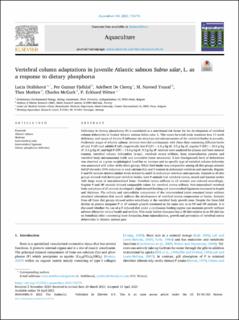| dc.description.abstract | Deficiency in dietary phosphorus (P) is considered as a nutritional risk factor for the development of vertebral column deformities in farmed Atlantic salmon Salmo salar, L. This mono-factorial study examines how 11-week deficiency and excess of dietary P influence the structure and microstructure of the vertebral bodies in juvenile, freshwater stages of Atlantic salmon. Animals were fed continuously with three diets containing different levels of total P (tP) and soluble P (sP), respectively: low P (LP) = 6.8 g/kg tP, 3.5 g/kg sP, regular P (RP) = 10.0 g/kg tP, 5.6 g/kg sP, and high P (HP) = 13.0 g/kg tP, 9.3 g/kg sP. Animals were analysed for plasma and bone mineral content, vertebral column deformities (x-ray), vertebral centra stiffness, bone mineralisation pattern and vertebral body microanatomy (cells and connective tissue structures). A low (background) level of deformities was observed on a gross morphological level but no increase and no specific type of vertebral column deformity was associated with either of the three groups. While feed intake was comparable among all diet groups animals fed LP showed a 50% reduction in total calcium (Ca) and P content in abdominal vertebrae and opercula. Regular P and HP animals showed similar levels of total Ca and P in abdominal vertebrae and opercula. Animals in all diet groups showed well-developed vertebral bodies. Low P animals had vertebral centra, neural and haemal arches with large areas of non-mineralised bone. Vertebral centra stiffness in LP animals was reduced accordingly. Regular P and HP animals showed comparable values for vertebral centra stiffness. Non-mineralised vertebral body end plates of LP animals developed a slight inward bending and intervertebral ligaments increased in length and thickness. The cellular and extracellular components of the intervertebral joints remained intact without structural alterations that would indicate the development of vertebral centra compression or fusion. Animals from all three diet groups showed active osteoblasts at the vertebral body growth zone. Despite the three-fold decline in plasma inorganic P in LP animals growth continued at the same rate as in RP and HP animals. It is discussed whether the use of a P-reduced diet under a continuous feeding regime can maintain growth without adverse effects for animal health and welfare. This study further discusses that a HP diet relative to an RP diet has no beneficial effect concerning bone formation, bone mineralisation, growth and prevention of vertebral centra deformities in Atlantic salmon parr. | en_US |
